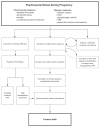Psychosocial stress in pregnancy and preterm birth: associations and mechanisms
- PMID: 24216160
- PMCID: PMC5179252
- DOI: 10.1515/jpm-2012-0295
Psychosocial stress in pregnancy and preterm birth: associations and mechanisms
Abstract
Aims: Psychosocial stress during pregnancy (PSP) is a risk factor of growing interest in the etiology of preterm birth (PTB). This literature review assesses the published evidence concerning the association between PSP and PTB, highlighting established and hypothesized physiological pathways mediating this association.
Method: The PubMed and Web of Science databases were searched using the keywords "psychosocial stress", "pregnancy", "pregnancy stress", "preterm", "preterm birth", "gestational age", "anxiety", and "social support". After applying the exclusion criteria, the search produced 107 articles.
Results: The association of PSP with PTB varied according to the dimensions and timing of PSP. Stronger associations were generally found in early pregnancy, and most studies demonstrating positive results found moderate effect sizes, with risk ratios between 1.2 and 2.1. Subjective perception of stress and pregnancy-related anxiety appeared to be the stress measures most closely associated with PTB. Potential physiological pathways identified included behavioral, infectious, neuroinflammatory, and neuroendocrine mechanisms.
Conclusions: Future research should examine the biological pathways of these different psychosocial stress dimensions and at multiple time points across pregnancy. Culture-independent characterization of the vaginal microbiome and noninvasive monitoring of cholinergic activity represent two exciting frontiers in this research.
Conflict of interest statement
The authors stated that there are no conflicts of interest regarding the publication of this article.
Figures
References
-
- Abeysena C, Jayawardana P, de Seneviratne RA. Effect of psychosocial stress and physical activity on preterm birth: a cohort study. J Obstet Gynaecol Res. 2010;36:260–7. - PubMed
-
- Ancel PY, Saurel-Cubizolles MJ, Di Renzo GC, Papiernik E, Breart G. Very and moderate preterm births: are the risk factors different? Br J Obstet Gynaecol. 1999;106:1162–70. - PubMed
-
- Austin MP, Leader L. Maternal stress and obstetric and infant outcomes: epidemiological findings and neuroendocrine mechanisms. Aust NZ J Obstet Gynaecol. 2000;40:331–7. - PubMed
-
- Bailey MT, Lubach GR, Coe CL. Prenatal stress alters bacterial colonization of the gut in infant monkeys. J Pediatr Gastroenterol Nutr. 2004;38:414–21. - PubMed
Appendix 1: Complete references
-
- Abeysena C, Jayawardana P, de Seneviratne RA. Effect of psychosocial stress and physical activity on preterm birth: a cohort study. J Obstet Gynaecol Res. 2010;36:260–7. - PubMed
-
- Alder J, Fink N, Bitzer J, Hosli I, Holzgreve W. Depression and anxiety during pregnancy: a risk factor for obstetric, fetal and neonatal outcome? A critical review of the literature. J Matern Fetal Neonatal Med. 2007;20:189–209. - PubMed
-
- Ancel PY, Saurel-Cubizolles MJ, Di Renzo GC, Papiernik E, Breart G. Very and moderate preterm births: are the risk factors different? Br J Obstet Gynaecol. 1999;106:1162–70. - PubMed
-
- Andersson L, Sundstrom-Poromaa I, Wulff M, Astrom M, Bixo M. Neonatal outcome following maternal antenatal depression and anxiety: a population-based study. Am J Epidemiol. 2004;159:872–81. - PubMed
Publication types
MeSH terms
Substances
Grants and funding
LinkOut - more resources
Full Text Sources
Other Literature Sources
Medical
Miscellaneous

